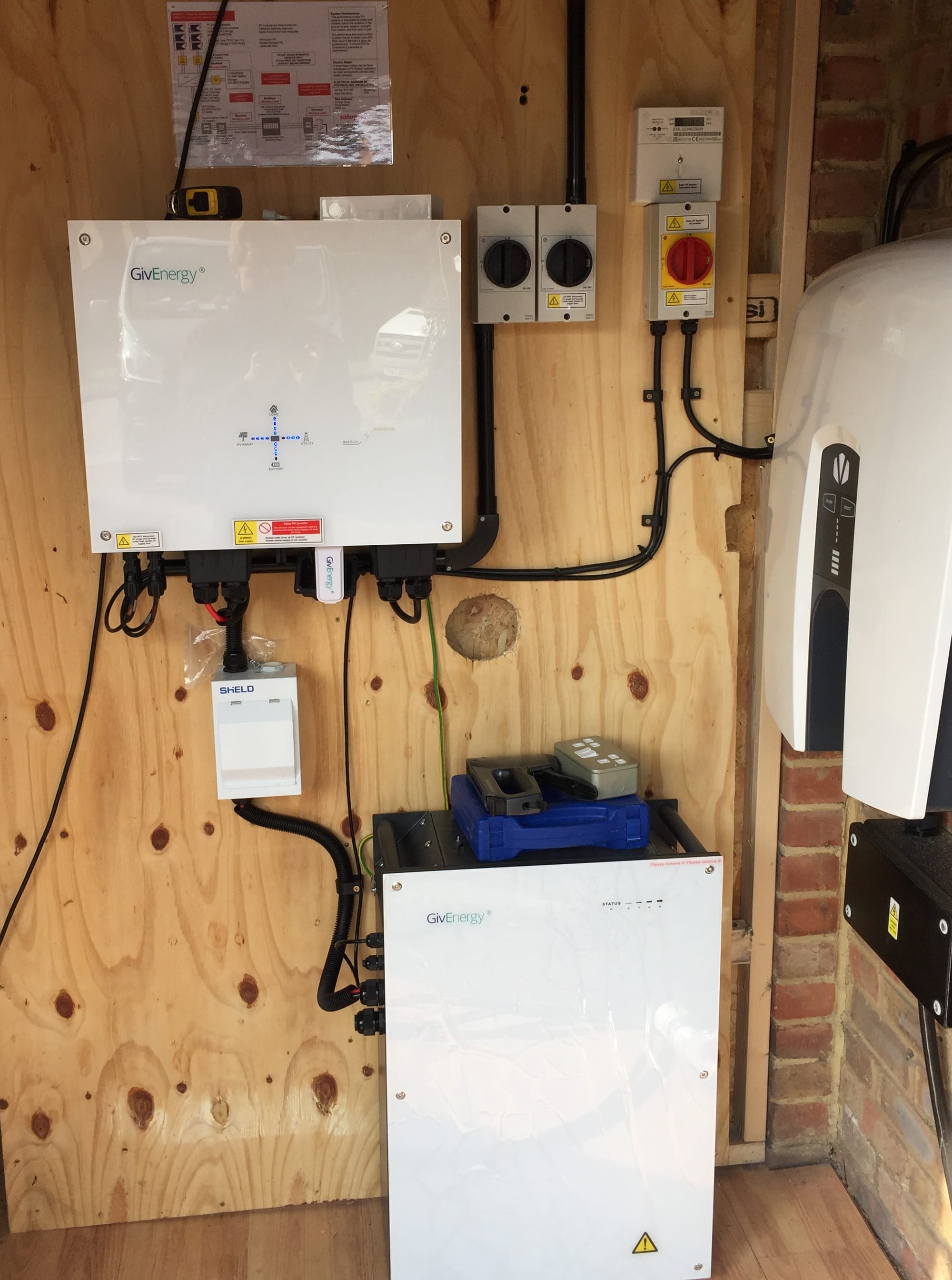BATTERY STORAGE

Solar Partner designs, supplies, installs and commissions battery storage systems. A battery storage system will reduce your demand for imported electricity.
Solar Partner only use products like GivEnergy that are widely used and supplied the leading trade suppliers in the UK.
Contact us for a free quote on 07919 686 076. We work within a 50 miles radius from Milton Keynes.
Make your own...electric.
Save your own...electric.
Some useful information -
Battery storage
Battery storage is a rapidly evolving technology that is typically used alongside solar PV. It allows surplus electricity generated by solar panels to be stored for later use rather than being exported to the Grid.
If you have solar panels you can generate plenty of electricity when the sun is shining. But on overcast days the solar panels will make less, and no electricity will be made at night. This generation pattern often doesn’t match up with when households want to use electricity - it’s at night when you want the lights on and to use appliances like a dishwasher or TV. Especially if you work away from home during the day.
If your solar panels generate electricity and you don’t use it, the surplus electric will be fed into the National Grid. You will only get paid a small amount for exported electric. This will be not as much as you save if you use the power yourself.
This is where battery storage is game changing. If you can store the electricity generated during the day, there is less need to consume electricity – e.g. run your washing machine – when the sun is shining and you’ll use more of the power you generate and save money.
Solar Partner prefers to install storage batteries in a garage, outbuilding, plant room or a barn. A 9.5 kWh GivEnergy battery measures approximately 80 cm x 60 cm x 25 cm.
In addition, some batteries can now export and import electricity directly into the grid, helping to balance national demand and supply issues, and also reducing carbon emissions at peak times. New methods to engage in energy trading are emerging, like selling electricity locally to neighbours or to a micro grid, or being part of an international ‘battery community’.
Is battery storage for me?
If you are a low electricity user and expect to recoup an investment quickly, battery storage probably isn’t for you. But it might be something to explore in more depth if:
- You want to maximise your self-generated electricity but can’t adapt household behaviour to achieve this. (i.e. you can’t use most of your electricity during the day, or produce significantly more electricity than you use).
- You want to play a proactive role in the future energy system and reduce carbon emissions.
- You want to be off grid or as energy self-sufficient as possible.
To assess the financial investment, you will need to know your annual household electricity usage, and the annual generation capacity - actual or expected - of your solar panels. Next you’ll need to consider likely installation costs based on the type of battery you want, and also any potential export payments.
What to look for ...
First off, the battery itself. Once you know your electricity usage and generation capacity you can think about the types of battery storage system that suits you. The points below are designed to help you do this.
It’s worth bearing in mind that battery storage is developing fast. By 2022 storage capacity in the UK (domestic and non-domestic) is expected to be 50 times what is was just two years ago, and such growth is likely to bring down the costs. Plus the technology itself - and associated services - is changing too, becoming more sophisticated and offering more options to those seeking to become more actively engaged in an increasingly decentralised electricity network.

1) Type of battery
Most home energy storage batteries are lithium-ion (which are also used in consumer electronics). These are lighter, smaller and longer lasting than lead-acid batteries. They have a high energy density (kWh/kg), so can store more electricity for their size, and can discharge a larger amount of power at any one time. They are also more efficient than lead-acid batteries in terms of energy loss, and need less care to maintain battery health. Unsurprising, then, that lithium-ion batteries are more expensive - which is why lead-acid tends to be used in off-grid properties where a lot more electricity storage is required.
2) Useable capacity of the battery
Capacity is how much electricity the battery can store in kilowatt hours (kWh). Useable capacity is less than total capacity, because batteries should not be discharged completely as it damages them (this is prevented by ‘charge controllers’). A 14kWh battery might have a useable capacity of 13.5kWh.
3) Number of ‘cycles’
One cycle is a full charge and full discharge, but this rarely happens. Batteries usually partially charge, so a 50% charge and discharge is half a cycle. If you know the number of warrantied cycles (i.e. the number of cycles you are guaranteed to get) you can work out how many kWh the battery will give you e.g. 10,000 cycles of a 12 kWh battery will give roughly 120,000 kWh. After time the battery will degrade and you will receive fewer kWh per cycle. Current batteries have cycles warrantied for 6,000-10,000 cycles. This is not the same as the product warranty, which is normally 10 years, although batteries last longer than this.
4) Charge/discharge rate
This is the power input and output in kW. Make sure that you have enough power output from your battery to run the appliances you use; a 5kW output can run a kettle, tumble drier or electric fire, but a 2 kW output probably can’t. If you can’t access enough stored battery power when you need it (the ‘bottleneck effect’) you’ll need to suppement your supply with grid electricity. Similarly, if you can generate 4 kW and your battery can only input 2.5 kW you are wasting 1.5 kW of power which you can’t store (but can export to the grid).
5) Price per kWh of storage capacity
There are various batteries available on the market, and at varying prices. If you are trying to decide between similar batteries, then the price/kWh of storage capacity is a useful way to compare different systems.
6) Power cuts
Some batteries do not provide backup if there is a power cut. Is this essential for you? If so it may require some rewiring, and you will need a larger storage capacity to accommodate that reserve.
7) AC or DC coupling
Solar PV needs an inverter, as does a battery. A system using DC coupling has a single combined inverter, while AC coupling requires separate inverters for battery and panels. The type of coupling used has implications for the system’s function and efficiency. Speak to an installer about this. The pros and cons of each are briefy:
AC coupling – pros
- More power – get the combined kWh power output of solar PV and battery inverters.
- Can be located separately for optimal performance. The battery works best at room temperature, while inverters should be cooler.
- Faults with battery/solar PV will not affect the other.
AC coupling – cons
- 1-3% less efficient power transfer.
- More expensive.
DC coupling – pros
- More efficient power transfer, as less energy lost.
- Often cheaper.
DC coupling – cons
- Less access to power.
- Inverter and battery must be located together, with trade off in efficiency.
- Fault on solar PV could knock out the inverter and render battery useless, and vice versa
8) Electric vehicles
An electric vehicle is a big battery on wheels, and if left at home during the day it could be set up to charge automatically when there is excess electricity being generated. Most households are unlikely to have both an electric vehicle and a battery storage system, simply due to costs. If you are planning to have both, speak to the installer about how they will interact with each other – especially in terms of battery capacity and discharge rates.
9) Smart grid-connected
Some batteries can be used not only to store electricity from a home’s solar panels, but also to store surplus electricity from the grid. Such ‘smart’ batteries draw power from the grid when it’s plentiful and cheap which can either be used at home later or sold back to the grid at a higher price in times of high national demand. Such ‘virtual power plant’ (VPP) services that help balance the national grid are rapidly evolving, but note that not all batteries can do this, and that there are unresolved issues around the finer details of their operation, for example whether this ‘re-exported’ electricity will be eligible for Smart Export Guarantee payments (see box). VPP services require an agreement with an energy company or a third party, and some energy companies may require a separate meter to be installed.
VPP services are one of several ways that battery storage could transform the relationship between households generating electricity and the grid. Others include micro grids (local independent grid networks), peer-to-peer trading (e.g. selling electricity to your neighbours) and communal energy supply (battery owners sharing their electricity with each other). Systems such as these take advantage of smart meters, and may include time-of-use pricing, where the cost of power is based on low or high national demand.
Export payments & current changes
The Feed-in-Tariff (FiT) scheme offered a financial incentive for electricity generated and exported to the grid, and thereby encouraged households to install renewable electricity generators – mainly solar PV, but also small wind turbines or hydro. The scheme was a success, and, as intended, the uptake of solar power rocketed and the price of installation dropped by 60%.
In April 2019 new applications for FiT payments ceased, and the government replaced it with the Smart Export Guarantee (SEG) through which energy companies with more than 150,000 customers are required to provide at least one export tariff by January 2020. Smaller companies can offer this voluntarily. SEG payments apply to renewable technologies certified through the Microgeneration Certification Scheme, and energy companies will need evidence of this as part of the application process. Battery storage systems are technically eligible for SEG, but certifying the technology under the MCS is still in process. Register on the MCS website for updates.
The design of SEG tariffs – the price per kWh for electricity exported and length of contract – is being left to energy companies. It is not a subsidy, so no minimum price has been set by government. The system is designed to be flexible, with householders being paid a market rate for the electricity they produce in a manner similar to small-scale commercial renewable generators. Tariffs are likely to become progressively more dynamic, based on demand at different times of the day.
For an up-to-date list of SEG export tariffs check the Solar Trade Association Smart Export Guarantee League Table. In October 2019 rates are 5.38p/kWh - roughly the same as the old FIT.
Installation and return on investment
On average installing a battery will cost £4,000-£8,000, with a useable capacity of 3.8-13.5 kWh, and a power charge/discharge of 2.0/5.5 kW. Remember to factor VAT into your costs. At the moment installing a battery with a solar PV system incurs 0% VAT, while retro-fitting a battery attracts 20%.
Working out your return on investment is not simple, but the following calculation will give you a very rough idea. For simplicity it assumes you are not already generating electricity (if you are, you could use an annual bill from before the solar panels were installed). The calculation also assumes that your battery is capable of storing all the electricity you generate and discharging it at a rate that meets your demand.
- Begin by comparing the annual kWh usage you pay your electricity company against your expected annual generation.
- If you would generate more than you use: divide the cost of the battery by your annual electricity bill. This gives you the number of years it takes to pay itself back, although remember the battery will degrade over time.
- If you use more than you would generate: first calculate your generation as a percentage of your annual usage (let’s say you generate 60% of your usage). Next calculate how much 60% is of your annual electricity bill (£300 of a £500 bill). Finally divide the cost of the battery by £300 to get the payback time.
- Once SEG payments become an option you can also calculate their payments into your return on investment.
If cost is your main consideration, and batteries are currently too expensive, then wait a few years for prices to come down. However, if you’re looking beyond the financial rewards e.g. want to be more energy self-sufficient or to be a proactive part of a decarbonising energy system – or because you just like the technology – battery storage might be for you.


